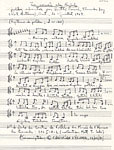|
|
|
MusicCanadians cannot point to any musical tradition and call it uniquely their own. They can claim, however, to have the world's most varied songbook, thanks to the nation's multicultural nature. This scope is very recent, though; until Canada attracted and accepted hundreds of thousands of immigrants from Third World countries, its music was almost exclusively European or American in origin. The grip that European music had on Canada beginning in colonial times was strongly emotional, religious or social. The United States had a further impact on our musical tastes*. Today's immigrants retain the pleasures of their homeland music and dance. Canadian involvement in music is ancient, if tenuous at times. Aboriginal peoples played instruments and performed religious or ritualistic dances. French missionaries introduced hymns, chants and carols to Aboriginal peoples as early as 1641**. English-speaking Church emissaries were equally inventive. Many of their songs survive in museums and archives today. Ballads are another form of early Canadian music. Very often they were pitiful expressions of lonely hearts or lost souls who longed to return home. The Banks of Newfoundland, Farewell to Nova Scotia, Un Canadien errant and The Red River Valley all fit this pattern. Equally important to early settlers were local marching bands - military, civic or fraternal. Philharmonic societies, symphonies, opera companies, music academies and conservatories, regional choirs, dance studios and ballet companies were formed nationwide. Victoria (1859), Quebec City (1868), Toronto (1886 and 1901), Montreal (1894) and Winnipeg (1939) became the performing centres of Canada, usually under royal patronage and invariably dominated by classical music lovers. Indeed, Canada's most revered musician is Glenn Gould, pianist and foremost interpreter of J. S. Bach***. If the urban elites had professional musicians regularly playing classical works in newly built concert halls, and if ordinary citizens contented themselves with local bands, singers and dances (folk, country, swing), then there was little common ground for universal tastes in music. What has changed this, and tremendously so, has been electronic recording, radio, television and the Internet. All have expanded the reach of every musical form and its performers beyond what anyone could have imagined. And together, these new media have truly democratized the world of music for Canadians. |
Bibliography · Links · Credits · Index


